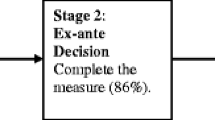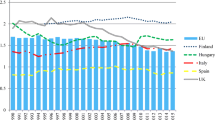Abstract
Governments in developed economies are making considerable investments in energy efficiency technologies and encouraging residential households to conserve energy. A major programme in Australia has invested A$280 million to encourage residential households to become more energy aware and make additional investment in energy efficiency measures. This paper examines the adoption of energy efficiency measures by residential households participating in this programme in a geographically remote Australian town. It uses data collected by the programme developers. It examines the financial return of the investment in terms of payback period and internal rate of return. It then discusses the financial return with respect to adoption of a range of products offered by the programme. Results show that adoption of energy efficiency measures by households was not solely guided by rational economic-maximising principles. For example, some frequently adopted measures had negative financial effectiveness. A range of important determining factors are discussed, and the consequent impact this has for analysis of the effectiveness of incentive programmes. Finally, this paper proposes considerations for future programmes to more effectively measure and target efficient adoption of energy efficient measures, both in remote and non-remote residential settings.




Similar content being viewed by others
References
ABS (2011). Australian Bureau of Statistics web site [WWW Document]. Alice Springs T Local Gov. Area Census Data. URL http://www.abs.gov.au/ (accessed 11.5.13).
Alice Solar City (2014) Alice Solar City 2008-2013 Report, Final Report. http://www.alicesolarcity.com.au/sites/default/files/Alice_Solar_City_Report_2008-2013%20FINAL%20for%20web.pd.
Brandon, G., & Lewis, A. (1999). Reducing household energy consumption: a qualitative and quantitative field study. Journal of Environmental Psychology, 19, 75–85. doi:10.1006/jevp.1998.0105.
Brennan, T. (2013). Energy efficiency policy puzzles. The Energy Journal, 34.
Bruderer Enzler, H., Diekmann, A., & Meyer, R. (2014). Subjective discount rates in the general population and their predictive power for energy saving behavior. Energy Policy, 65, 524–540.
Clinch, J. P., & Healy, J. D. (2000). Cost-benefit analysis of domestic energy efficiency. Energy Policy, 29, 113–124.
DeCanio, S. J. (1998). The efficiency paradox: bureaucratic and organizational barriers to profitable energy-saving investments. Energy Policy, 26, 441–454.
Devabhaktuni, V., Alam, M., Shekara Sreenadh Reddy Depuru, S., Green, R. C., II, Nims, D., & Near, C. (2013). Solar energy: trends and enabling technologies. Renewable and Sustainable Energy Reviews, 19, 555–564. doi:10.1016/j.rser.2012.11.024.
De la Rue du Can, S., Leventis, G., Phadke, A., Gopal, A. (2014). Design of incentive programs for accelerating penetration of energy-efficient appliances. Energy Policy, 72, 56–66. doi:10.1016/j.enpol.2014.04.035.
Dubin, J. A., & McFadden, D. L. (1984). An econometric analysis of residential electric appliance holdings and consumption. Econometrica, 52, 345–362.
Gamtessa, S. F. (2013). An explanation of residential energy-efficiency retrofit behavior in Canada. Energy and Buildings, 57, 155–164.
Gatersleben, B., Steg, L., & Vlek, C. (2002). Measurement and determinants of environmentally significant consumer behavior. Environment and Behavior, 34, 335–362. doi:10.1177/0013916502034003004.
Gillingham, K., Newell, R., & Palmer, K. (2006). Energy efficiency policies: a retrospective examination. Annual Review of Environment and Resources, 31, 161–192.
Howarth, R. B., Haddad, B. M., & Paton, B. (2000). The economics of energy efficiency: insights from voluntary participation programs. Energy Policy, 28, 477–486.
IEA (2013). CO2 emissions from fuel combustion, edition released on 19 November 2013. doi:10.5257/iea/co2/2013.
Jaffe, A. B., Newell, R. G., & Stavins, R. N. (2004). Economics of energy efficiency. In C. J. Cleveland (Ed.), Encyclopedia of energy (pp. 79–90). New York: Elsevier.
Jakob, M. (2006). Marginal costs and co-benefits of energy efficiency investments: the case of the Swiss residential sector. Energy Policy, 34, 172–187.
Lefley, F. (1996). The payback method of investment appraisal: a review and synthesis. International Journal of Production Economics, 44, 207–224.
Levine, M. D., Koomey, J. G., McMahon, J. E., Sanstad, A. H., & Hirst, E. (1995). Energy efficiency policy and market failures. Annual Review of Energy and the Environment, 20, 535–555.
Mallaburn, P. S., & Eyre, N. (2014). Lessons from energy efficiency policy and programmes in the UK from 1973 to 2013. Energy Efficiency, 7, 23–41.
McKenzie, M. (2013). Pre-payment meters and energy efficiency in indigenous households. Report by Bushlight, the Centre for Appropriate Technology: Alice Springs, Northern Territory.
Mishan, E. J. (1972). Elements of cost-benefit analysis. London: Allen and Unwin.
Mott, G. (1990). Investment appraisal for managers. England: Gower Publishing Co. LTD.
Mundaca, L., Neij, L., Worrell, E., & McNeil, M. (2010). Evaluating energy efficiency policies with energy-economy models. Annual Review of Environment and Resources, 35, 305–344.
Osborne, M. J. (2010). A resolution to the NPV-IRR debate? The Quarterly Review of Economics and Finance, 50, 234–239.
Prime Minister’s Task Group on Energy Efficiency (PMTGEE) (2010). Task group’s full report to the Australian Government. Report to Northern Territory Government by the Australian PV Association.
Rosenow, J., Platt, R., & Flanagan, B. (2013). Fuel poverty and energy efficiency obligations—A critical assessment of the supplier obligation in the UK. Energy Policy, 62, 1194–1203.
Sanstad, A.H., Howarth, R.B. (1994). Consumer rationality and energy efficiency. Proceedings ACEEE Summer Study Energy Efficiency in Buildings, (pp. 175–183). Washington, DC: American Council for an Energy-Efficient Economy.
Santamouris, M. (2001). Euroclass: a European method for the experimental evaluation and classification of residential buildings. In: Proceedings of the presentation of SAVE project on energy legislation in the building sector. Athens, Greece. 25 July 2001.
Scott, S. (1997). Household energy efficiency in Ireland: a replication study of ownership of energy saving items. Energy Economics, 19, 187–208.
Steg, L. (2008). Promoting household energy conservation. Energy Policy, 36, 4449–4453.
Stephenson, J., Barton, B., Carrington, G., Gnoth, D., Lawson, R., & Thorsnes, P. (2010). Energy cultures: a framework for understanding energy behaviours. Energy Policy, 38, 6120–6129.
Wada, K., Akimoto, K., Sano, F., Oda, J., & Homma, T. (2012). Energy efficiency opportunities in the residential sector and their feasibility. Energy, 48, 5–10.
World Bank (2012). http://data.worldbank.org/indicator/EG.USE.PCAP.KG.OE World Bank. 2009–2012. Energy use (kg of oil equivalent per capita). Data retrieved 21 February 2014 from World Bank: World Development Indicators database.
Wyld Group (2011). Mid-term review of the solar cities program. Commonwealth Government, Department of Climate Change and Energy Efficiency.
Zahedi, A. (2010). Australian renewable energy progress. Renewable and Sustainable Energy Reviews, 14, 2208–2213.
Acknowledgments
The research was conducted using a methodology approved by the Charles Darwin University’s Human Research Ethics Committee (approved application H13039). The authors would like to acknowledge the Alice Springs Town Council for their support of this project and are also grateful to the referees whose careful reviews led to improvements in this paper.
Author information
Authors and Affiliations
Corresponding author
Rights and permissions
About this article
Cite this article
Havas, L., Ballweg, J., Penna, C. et al. Energising households: a financial analysis of incentivised energy efficiency measures in remote Australia. Energy Efficiency 8, 951–962 (2015). https://doi.org/10.1007/s12053-015-9326-6
Received:
Accepted:
Published:
Issue Date:
DOI: https://doi.org/10.1007/s12053-015-9326-6




